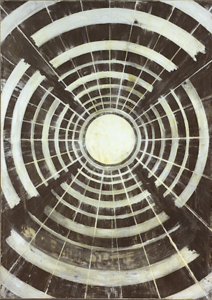Today’s post comes from Gabrielle Miranda, class of 2018 and Art Center Student Docent.
In honor of Touch the Sky, a temporary exhibition that explores intersections of art and astronomy, the Art Center offered live music, space-themed children’s activities, and a trip to Vassar’s observatory on June 23 for our Late Night programming. The night was met with great success and many visitors, the majority of whom came during the tail end of our Late Night hours just before we all made the trek to the observatory.
This was especially true for the children’s arts and crafts as the majority of our younger visitors came in the last hour. In addition to a kid-friendly tour of Touch the Sky, we had three different craft tables each with its own activity. Alexander-Calder-esque mobiles were constructed with hanging stars, planets, and moons that came together to form miniature galaxies little ones could take home.

At another station, visitors were able to use white and yellow crayons, watercolor paint, and coarse-grained salt to make stunning depictions of the night sky. Many of the resulting images recalled the soft colors of Laura Battle’s 2015 work How long is your past, how far is your future, which was commissioned especially for the exhibition.

The third activity recalled Mishka Henner’s 2011 twelve-volume book, which depicts our solar system to scale in 6,000 pages and also by Kiki Smith’s lunar images.

The children were given accordion-style books on black paper where they could depict the phases of the lunar cycle, our solar system, or something astronomical of their own invention.
Just before the galleries closed I led a family-friendly tour that began in Touch the Sky, but serendipitously ended in a comparison by one of the children of Ellsworth Kelly’s 1959 work Block Island to a UFO. I hadn’t given any tours to children in several weeks, and this was a refreshing reminder that kids always see something new! As Craig Chin from the ambient music duo Errant Space improvised music inspired by the galleries and the people wandering through them, the evening drew to a close and we all prepared to head to the Class of 1951 Observatory.
Because only one person at a time could climb up the ladder to the telescope to see the cosmos they’d been learning so much about in the Art Center galleries, a long line trailed the machine. Thanks to the observatory staff, the line moved along swiftly. However, because of the time it did take to give everyone a chance to see, Jupiter, which was visible at the beginning of the night, sunk beneath some trees on the horizon. Slightly disoriented yet thoroughly impressed, I watched the roof of the observatory rotate above me so that the next group of visitors could take a look at Mars. Finally my turn, I got to see Saturn and three of its moons for the first time and could make no exclamation other than “oh my goodness!” It was unlike anything else to get to see something in real life that I had only seen depicted in textbooks—or in the art on view in Touch the Sky.
All told, it was clear to me and the other attendees of the Art Center Observatory Night that while the cosmos may not be totally visible to the naked eye, what we can see (through science and art) never fails to be awe-and-art-inspiring.




